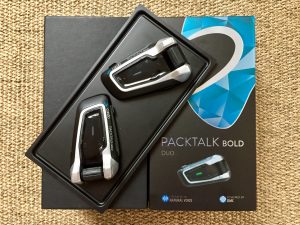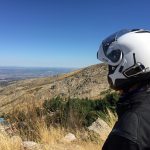Scala Rider Packtalk Bold – Intercom Review
For a long time my girlfriend Birgit didn’t want to have intercom. She thought it would intrude on her riding thinking space. We’d also tested a few when rider to rider intercoms first came out and she’d loathed the things. They were distracting, noisy and inefficient. But good news, technology for intercom systems has moved on dramatically over the past couple of years and Cardo Systems are at the forefront of the developments.

I’m making a point of noting this because flip fronts are noisier than full face helmets and that means an intercom unit’s abilities are going to be stretched hard.
First of all, fitting the equipment is logical and straight forward. The speakers have a shorter wire running to the control unit and a longer wire which connects the speakers together. This longer wire also acts as the antenna for the radio and it fed through easily under the lining of my helmet, and the speakers themselves into the helmet cut outs. There are Velcro fasteners for the speakers, and pad inserts if your helmets cut outs for the speakers are too deep. It took me a few attempts to get the speakers in the right place. Everyone’s ears sit differently on their heads so you’ll need to play with this a bit. Get them in the wrong place and you’ll be wondering why they are so rubbish, when they really aren’t.
The Packtalk Bold gives several options for fitting the microphone, depending on what type of helmet you have. Ours being flip front helmets took advantage of the boom mike, which fitted easily and firmly. You do need to pay attention to where you are seating the mike both for proximity to the mouth but also so that the fastening point is strong; it’s going to get a lot of movement over its lifetime.

I’m not a techie type of guy so setting the intercom up was not something I was looking forward to. I actually read the instructions and my first thought was how clear they were; lots of pictures! Hopefully they would be easy to follow. They were!
After pressing a couple of buttons, synching the two units via the DMC (Dynamic Mesh Communication) Intercom grouping option took just a couple of minutes. We could now talk. Using the DMC mode you can connect up to fifteen riders and the claim is a five mile range! This is achieved because in DMC mode the units piggy back on each other creating a sort of chain. You can also use Bluetooth to connect with each other and if you ride in a group of four or less then the Bluetooth set up may be the one for you. The specs say that a group on Bluetooth is also a far less power hungry option. We haven’t actually tried either multiple connect options yet but I don’t see why setting this up should be any more complicated than connecting one to one. Once your units have synched, unless you take the units back to factory setting, they will instantly recognise each other when are turned on and close to each other.

When you start a day’s ride and you press two buttons, for literally a second, to fire the system up, Cardo rather pleasantly confirms that she’s awake and what you are connected to; as in the other rider or riders, and your phone or GPS. You can connect to all three at the same time.
One of the things we really didn’t like about the old Q3 intercom we’d had, and others we’ve tried, is that the voice activation systems have been slow, awkward and unreliable. Don’t laugh (oh, ok, do). One set up we tried had a real activation problem. We found that the only way to get it going was to bleat loudly like a constipated sheep into the microphone! OK on the open road, but moving slowly in town had pedestrians looking round to see where the flock was! And even then, you had to wait for the activation to occur.
Well, you don’t have that problem with the voice activation of this set up. It’s instant and it doesn’t matter how much wind noise there is. Fantastic. The noise cancellation ability is superb.
The Packtalk Bold has voice activated instructions for the various possibilities. Volume up or down, radio on, music on, making a phone call and so on. You can even voice command a battery level check. Once I’d got used to the fact that this system is American, that I didn’t need to talk loudly to it to make it understand me but that I needed a slight American accent for some of the commands, it worked beautifully. “Hey Caardo, volume up.” Job Done. “Hey Caardo, music on.” Sorted. “Hey Caardo, baddery stadus.” Wow, 50% still and after a full day’s riding and chatting. That’s great.
As a backup to the voice operation you can either press buttons on the unit or there’s a very effective roller for volume levels, taking phone calls and so on. Talking of phone calls, you can even share calls to the whole group while you are in DMC mode. We didn’t try it.
The battery life on the set up is spot on. We use the intercom mostly for comments such as “Hey, look left!” “I think Co-Pilot means the next turning.” “That café looks really nice; fancy a coffee.” “Idiot on the right coming up.” “Yeah, that tent pitch looks great. Sheltered from the wind and its going to get the sunshine in the morning but shade in the day. Let’s take it.” Battery level was still at 25% after two full days of riding and these sorts of comments. Music eats the charge though. I ride with custom made ear plugs and so have the volume right up and within a long riding day of music and chat the battery will be flat. I think that’s acceptable though. After all, I am making it work hard.

The max range on an open straight road was just over a mile. In the twisties but no buildings or hills just trees, we managed about three quarters of a mile. In the city, with corners and buildings we’d lose each other at around half a mile. We were impressed! The flip up antenna does make a difference!
Birgit had dreaded the fact that I often sing in my helmet when riding. She found the mute button on the PackTalk Bold very quickly.
Packtalk Bold Duo Price: £429 to £549
